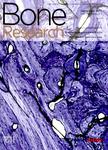Osteoclasts:New Insights
Osteoclasts:New Insights作者机构:Department of PathologyThe University of Alabama at BirminghamBirminghamAlabama 35294USA Department of Pathology and ImmunologyWashington University School of MedicineSt.LouisMissouri 63110USA
出 版 物:《Bone Research》 (骨研究(英文版))
年 卷 期:2013年第1卷第1期
页 面:11-26页
核心收录:
学科分类:1002[医学-临床医学] 100201[医学-内科学(含:心血管病、血液病、呼吸系病、消化系病、内分泌与代谢病、肾病、风湿病、传染病)] 10[医学]
主 题:osteoclast bone remodeling M-CSF RANKL integrin avβ3
摘 要:Osteoclasts, the bone-resorbing cells, play a pivotal role in skeletal development and adult bone remodeling. They also participate in the pathogenesis of various bone disorders. Osteoclasts differentiate from cells of the monocyte/macrophage lineage upon stimulation of two essential factors, the monocyte/ macrophage colony stimulating factor (M-CSF) and receptor activation of NF-κB ligand (RANKL). M-CSF binds to its receptor c-Fms to activate distinct signaling pathways to stimulate the proliferation and survival of osteoclast precursors and the mature cell. RANKL, however, is the primary osteoclast differentiation factor, and promotes osteoclast differentiation mainly through controlling gene expression by activating its receptor, RANK. Osteoclast function depends on polarization of the cell, induced by integrin avβ3, to form the resorptive machinery characterized by the attachment to the bone matrix and the formation of the bone-apposed ruffled border. Recent studies have provided new insights into the mechanism of osteoclast differentiation and bone resorption. In particular, c-Fms and RANK signaling have been shown to regulate bone resorption by cross-talking with those activated by integrin avβ3. This review discusses new advances in the understanding of the mechanisms of osteoclast differentiation and function.



